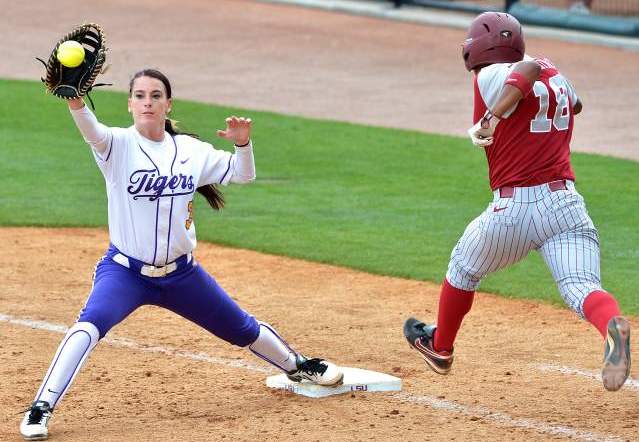There is a common presumption that playing first base isn’t complicated. What’s worse is the misleading misconception that this position should be manned by the seemingly weak athletes, because there is no much activity- running, throwing, or moving- involved. But is that the case, really? NO!
This position could be as tricky as any other position on the softball diamond. The first base has its challenges that call for some special skills to be ingrained into the candidates. For instance, first base players come into contact with about every hit directed to an infielder. You will also have to manage several defensive plays in the course of the game.

The bad news is that you must scoop all balls from inaccurate throws without questioning. By the same vein, you will, at one time or another, be required to make throws, which need to be very accurate.
As you can see, keeping things in control in the first base requires some degree of seriousness like any of the other 8 positions. The modern coach will want to put agile, quick, and super flexible defensive players on first base. That could be anyone else including you.
Read more:
You just need a few tips on how you can be lethal enough for this corner. In this article, I have several tips on how to be an effective first baseman. I won’t stop at that. I also have another set of tips on how to play excellently on second base.
Techniques, Strategies, and Tips of Playing First Base
It boils down to proper footwork
I’ll not be the first to tell you that excellent footwork is an essential trick in your arsenal. As a defensive player, it pays to know exactly where each of your foot should be in different circumstances. This will crazily boost your range and balance which increases your performance in return.
Excellent footwork also optimizes the distance that you’re able to cover without leaving the bag. It also keeps the runners on their toes.
Sprint to first base, IMMEDIATELY
One thing is always certain. If the ball is directed to anyone else- the pitcher, second baseman, or third baseman- but you, you are the next culprit. As such, dash to the first base immediately and take your position.
Importantly, remember to position the gloved hand opposite your foot. For instance, right-handed players should have their left foot forward, and vice versa.
Inside the bag, you need to square up by turning your head and facing the thrower with the heels firmly grounded on the base. This not only sends signals to the thrower that you are on your lethal mode, but it also allows you to navigate the base efficiently without getting your eyes off the ball.
Not every hit is a perfect one
Another important aspect here is to expect imperfect throws. Sure, no one will release a nice one especially if they figure out how outstanding you are.
In that case, you need to perfect your skills of catching less perfect throws. Have some drills where a teammate throws the ball less perfectly, for instance, in the dirt or up and down the line. Being able to catch these throws will sharpen your abilities in the game, and you’ll always be surprising the thrower and the coach. Perfecting these skills also help you to recognize wide and imperfect throws and be able to make the best reaction.
Stay inside the bag
Always maintain your foot inside the bag. An important reminder is to avoid charging or positioning yourself halfway up the line not unless the thrower makes a positive bunt. A tight charge may put you at the risk of a slap or even be pushed toward the fourth hole. Again, committing over halfway when you are not sure of a bunt could render you susceptible to confusion when the bunter slaps the ball the other way.
Why the stretch matters
First basemen should be very keen to the direction of the throw in relation to their footwork. For instance, if the ball is thrown wide of you, on either side, remember to maintain some contact with one foot and move it to the furthest corner as possible while stretching for the ball.
If you are sure that a throw will bounce before reaching you, you need to drop like a catcher without leaving the base. You might also try to block the ball and even secure it in your gut, at the least.
Effective tips of how to play second base
Moving to the second base, things start getting a little bit tough. Here, you’ll have to cover a big area between the first and the second base. You also need to turn double plays and at the same time catch fly balls and cover the bag.
Perfect your stance
With all the duties that befall you as the second baseman, you need to be both super flexible and mentally prepared. Always be swift in your moves and be light on your feet.
Be synced into the pitcher’s motion
As the second baseman, the pitcher is the person to fix your eyes on. You need to read his mind and predict his next move. But remember to glue your eyes to the ball too. This is not the time to rest lazily on your knees.
Square your feet
To highlight the sync that you have with the pitcher and other infielders, you need to square your feet shoulder-width apart and be ready for action. You also need to bend your knees and straighten your back at the waist.
Making relay plays without collision
Sometimes, the second baseman is ordered to leave her base and catch shallow-flying balls to relay them to the appropriate base. That being said, you need to maintain excellent communication skills to prevent collisions. It’s also recommended to forcefully yell, Ball, or I got it, to avoid collision with other infielders.
Manning the base
It’s also your responsibility to man the bag on every grounder or when the ball is hit to the left. In case a runner is on the first base when the ground ball is hit, she has to race to second. The baseman needs to sprint to the bag and position his back foot on it while extending the glove to the teammate.
Conclusion
To become an exceptional first and second baseman, there is need to understand more about the mechanics involved rather than the motions. The most important aspect is to perfect your stance. You should also ensure excellent communication within the team and carry out some drills with some teammates to help you perfect these tips.

Hello everyone, I’m Darron and head Editor of this site. I’m so proud to be a part of this project.
